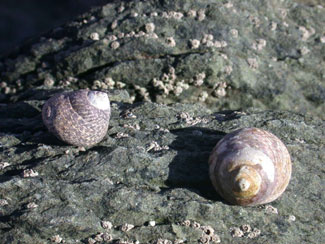| 2003 |

|
YEAR BOOK |
Galway-Mayo Institute of Technology & University College Cork
|
Monitoring intertidal community change in a warming world
|

A variety of intertidal species ranging from cosmopolitan to cold water boreal and warm water Lusitanian can be found along Irish coasts. If the climate was to alter, these species may undergo an increase or decrease in their abundance and/or geographical range.
Throughout the past 50 years, a variety of intertidal community studies have taken place around Ireland. One such study was conducted by Alan Southward and Dennis Crisp during the summers of 1950, 1952 (Southward & Crisp, 1954) and 1958. Overall, they sampled 205 rocky shore sites with 165 in the Republic and 40 in Northern Ireland. They documented over 60 species, while giving them an abundance score based on the semi-quantitative logarithmic ACFOR (Abundant, Common, Frequent, Occasional and Rare) scale. This extensive data set is being used throughout our project as a baseline against which changes can be assessed.
During the summer of 2003, we resurveyed 72 of Southward and Crisp's original sites. On each rocky shore, we recorded the abundance of 57 intertidal indicator species using the ACFOR scale. We also collected and examined quantitative data on the distribution, abundance and population structure of key indicator species, such as the top shells Osilinus lineatus and Gibbula umbilicalis .
This study forms the Irish contribution to a joint UK and Ireland Marine Biodiversity and Climate Change (MarClim) project ( www.mba.ac.uk/marclim ). The aims of this project are to:
|
1)�Assess changes in the intertidal communities around the islands of Ireland and Great Britain;
2) Use previous studies and modern techniques to determine whether any change can be attributed to climatic factors; 3) Use the data collected through our current resurvey to predict intertidal community changes in the future; 4) Identify indicator sites and species for future monitoring. |
Reference:
Southward, A.J. & Crisp, D.J., (1954): The distribution of certain intertidal animals around the Irish coast. Proceedings of the Royal Irish Academy, 57 , Sect B.
Contact: Christina Simkanin, E-mail: [email protected]